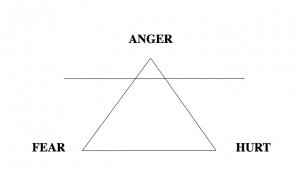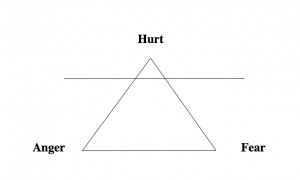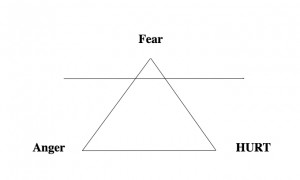Emotions Can Seem Tricky
Like it or not, emotions, which can seem tricky, play a crucial role in the heat conflict. Here’s a way to deal with the way emotions can be confusing when you manage conflict.
Anger seems to be the feeling most often expressed while under stress with our partners. So, consider this: If anger is the most frequently generated and expressed emotion during your conflicts, that anger may be a cover for other, unexpressed emotions, which, were they expressed, might help manage the conflict more effectively.
The following graphic illustrates this:
The tip of the triangle illustrates anger as the expressed emotion. Below our consciousness, represented by the horizontal line, lurk two other emotions—fear and hurt. In my experience, anger and hurt are almost always present in tandem.
When anger is felt, there is a good chance that some hurt is also present but unconscious, and, therefore, not being expressed. Frequently, chronically angry people are feeling more hurt than they are anger, yet the hurt goes unexpressed, while the anger takes center stage.
There are several possible reasons for this: One, the angry person has learned that anger keeps people at a more comfortable distance, even if the distance is not consciously desirable.
Two, some individuals do not want others, perhaps their partner in particular, to know they feel hurt because one or both believe hurt is a sign of weakness; conversely, the belief is that anger is a badge of strength.
Three, anger tends to leave some folks feeling energized and powerful. All in all, anger serves as a defense against hurt when hurt is left unexpressed no matter the reason.
Commonly, angry people are also running scared, so fear occupies the other corner of the triangle. Whether hurt or fear, the anger defends against both. It is simply too risky, for what ever reason, to express either one.
Now, rotate the triangle, and put one of the other two emotions at the top. It looks like the following:
In this example, hurt and anger are reversed. Expressing hurt may defend against the expression of anger for the following possible reasons:
One, anger signals aggression, and some individuals are afraid of their own, or their partner’s, aggression and anger. Frequently they came from an aggressive and/or angry background.
Two, the reverse may be the case—family of origin conflict did not include or permit expression of anger or aggression, and it resulted in feeling afraid of anger. therefore, expressing hurt was acceptable. In short, both family histories may invoke the same outcome.
Three, hurt people also may be afraid—living in fear.
If expressing fear seems dangerous, expressing hurt instead is a viable option. Bottom line is, hurt now becomes the primary defense against anger and fear.
Once again, rotate the triangle.
In this instance, fear provides an opportunity to defend against anger and hurt, for exactly the same reason: anger and hurt are unacceptable. Parking hurt and anger below conscious awareness makes an individual feel safer. These principles apply regardless which emotion is at the top of the triangle
Bottom line is this: The more completely we express ourselves, the more likely we will be fully understood. And that is a good thing!
Fine, you say, but now that I know this, so what? Start with this:
Notice which triangle best fits you and your partner. You might each have different triangles. Next, take the time to check in with yourself when you express what you are feeling, and take a risk to express one or both of the feelings on either bottom corner of your triangle, assuming those feelings are lurking there.
If you are equally likely to express all three emotions, good for you!
While your partner is talking, listen for the possibility that, depending on which feeling is at the top of their triangle, one or the other emotion at the bottom corners is being left unsaid.
Take a risk to say something like: “I can see that you are really angry (or, fill in the blank with the dominant feeling they are expressing) and I’m wondering if another part of you is also feeling hurt or afraid (or, fill in the blank with the feelings that best matches their triangle.)?”
When partners are conscious of their, and their partner’s triangle, and change their responses because of that knowledge, emotional reactivity tends to reduce, greater mutual understanding occurs, and the gap between them decreases.
Before you try it in real time, feel free to talk about it with your partner in a neutral moment. You will promote a safe emotional environment if you talk about YOUR triangle, and not your partner’s.
Wishing you a satisfying relationship,
Jim Hutt, Ph.D., MFT
©2010 All rights reserved













Jim,
This is very helpful… in many relationships. I’m going to observe this for the next few days in my own life. It seems kind of unthreatening to look at the relationships as having “emotional triangles” … more objective.
What if we replaced the words with the opposite emotion… perhaps these would be the result, ultimately.
Anger (a feeling of extreme annoyance, irritation):
opposite – calm, peaceful
Fear (apprehension or distress by presence of anticipation of danger):
opposiitie – confidence, self-assurance
Hurt (to feel emotional pain):
opposite – help, rally around
Thanks for sharing this.
– Kathleen
Comment by Kathleen Jin — October 26, 2010 @ 1:20 pm
I wish i would have read this 2 days ago.. Months with my therapist, and you have given me more insite in 1 article over the months working with a therapist… Thank you
Comment by Kristin Ball — October 26, 2010 @ 8:55 pm
It makes sense. There is a structured approach to do this. It helps us to understand our own self better. Thankyou.
Comment by lata.r.iyer — October 26, 2010 @ 9:32 pm